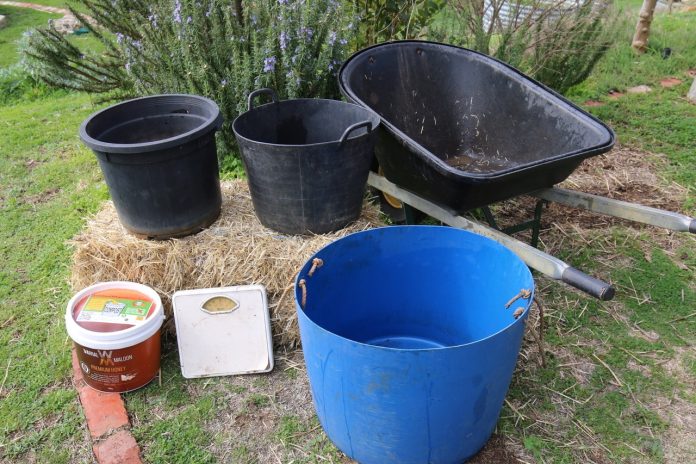When we first learn to cook, a recipe is our lifeboat, and we follow it to the letter. As we begin to trust our intuition, we need the recipe less and less, substituting an ingredient here, estimating a measure there, cooking more by feel than by the absolutes of cups or grams.
Even when we cook like this, there are scoops, spoons and vessels in our kitchen that we learn to know and trust.
So too, with good compost practice, the more experienced we get, the less we need to follow the recipe. But, some loved and well-trusted measures and vessels can really help us do the job well. Let’s have a look at a few of my favourites.
At YIMBY, our contributing households give us their food scraps in reclaimed 10-litre food-grade buckets. A full bucket of food scraps weighs five to six kilograms – not too heavy for most people to lift – but average households give us 2.2kg per week. We use a sharp spade to chop up the contents in the bucket before adding them to the compost.
What size vessel do you collect and carry your kitchen scraps out to the garden in?
YIMBY composters use bathroom scales to weigh the food scraps in the buckets before blending them in the compost, processing about 35 to 50kg of food scraps each week – perfect for our continuous hot compost system. Cool composters won’t need anything like this amount.
Have you weighed your weekly food scraps? How much does your household average per week?
We like to use a 100-litre tub (a half 200-litre barrel with rope handles) to soak dry, carbon-rich ingredients before blending them into the compost. I need a full tub of soaked straw to balance a smaller (35kg) batch of food scraps, and might need to fill it twice for a big weekly compost ‘segment’ (as we call them).
I have a second ‘soak’ tub for autumn leaves. They’ll get a good wetting before going into the pile in summer, or if the compost is feeling dryish. I know I need at least one of these filled (plus the soaked straw) to balance the nitrogen-rich additions in a medium-sized batch of food scraps.
I have a range of other 35 to 50-litre big flower pots or plastic ‘totes’ that are great for a batch of aged wood-chips or chopped up garden prunings to be the ‘structure’ our pile needs to keep the pile well aerated and breathing freely.
It is only when I have all these ingredients ready, roughly measured out in their vessels, and soaked – if needed – that I start layering up my compost for the week.
My trusty Sherlock wheelbarrow is used to measure out the finished compost going to the garden. I know I get seven barrow loads full from my larger compost bays, and just under six from my cubic metre (1000-litre) Beckley Bays.
Do you have some favourite ways of measuring your compost ingredients?
– Joel Meadows works with *Yes In My Back Yard, (YIMBY), a community-scale composting initiative in Castlemaine and surrounds. Send questions or comments to hello@yimbycompost.com, or to book in for a compost workshop.







